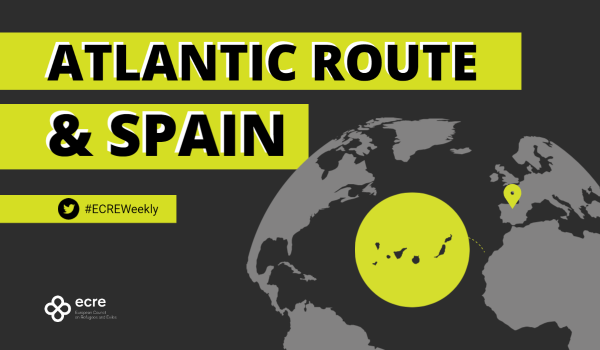Moroccan authorities open gunfire at a boat carrying migrants leaving one woman dead, many injured and three in severe condition. The incident comes amid strengthened cooperation with the EU and Spain while no advancements in the investigation of the Melilla tragedy and already 1.000 migrants have died or disappeared on the Canary route.
The Caminando Fronteras Organization announced on 12 September that Moroccan forces opened gunfire at a boat of migrants leaving many injured to prevent their departure to the Canaries. Reportedly, one of the victims is a sub-Saharan woman who got shot in the chest and died. Among the wounded migrants, three are in severe condition. Also, two men were hit by a car while trying to escape the gunfire. This is not the first incident of its kind. In September 2018, the Moroccan navy killed a woman and injured three after shooting at a migrant boat. During the past months, Moroccan authorities have strengthened their interventions as border guards on the EU’s behalf. In return, Morocco is receiving Spanish and EU funds, as well as political concessions. Spain and Morocco have renewed a security cooperation agreement that came to force on30 April 2022. According to Statewatch “reinforcing their border securitisation policies, in line with European migration policies, which increasingly criminalise the migration process”. Furthermore, following the recent tragedy in Melilla leaving at least 37 people killed and more than 300 injured, the EU has introduced a new operational partnership with Rabat doubling economic allocation to Moroccan migration management, with 500 million EU funds expected to cover the 2021-2027 period. This has already translated into abusive border management, including frequent raids to the migrant camps and harsher control in border-crossing attempts in the past months. In a recent report from the Moroccan Association of Human Rights (AMDH), the organisation highlights the unprecedented efforts of Moroccan-Spanish cooperation to prevent migrants from getting closer to the Spanish border through the arrest of migrants, destruction of camps, goods confiscation and even blocking access to food to hundreds of people.
Meanwhile, there are no institutional advancements to assign accountabilities or clarify the causes of the Melilla tragedy. In this regard, the Socialist Spanish party in the presidency (PSOE) and right-wing political parties blocked on 12 September three proposals that aimed at creating a commission of inquiry to clarify the causes surrounding the deaths and violence that occurred on Melilla’s border. While no further actions are taken at the political level, at least 65 of the migrants that were pushed back have already faced criminal charges in Morocco over the border crossing attempt, resulting in at least 14 people being sentenced to two and a half years in prison and a fine of 10.000 dirhams and another 33 migrants convicted to 11 months of imprisonment and small fines. The AMDH strongly accused the Spanish and Moroccan authorities of their complicity in the deaths and affirmed they are partially accountable for the tragedy for not mobilising their ambulances and rescuers and deliberately refraining from helping the wounded migrants in their territory. Even though local organizations warned against burying the corpses before identification and autopsies, local NGOs said that the Moroccan authorities seemed to be organizing hasty burial of corpses of the dead migrants while preventing journalists’ access to the tomb preparation in an attempt to “hide the disaster”. Furthermore, it has been recently questioned whether the Moroccan intelligence services knew about the migrants’ gathering around the border before the incident and thus could have avoided the deadly consequences in advance. Although the Melilla tragedy was defined as the worst human disaster on Europe’s border with Morocco and described as an isolated incident, local organizations know it is not unusual.
People keep risking their lives on the Atlantic route to the Canary Islands despite Rabat’s soared surveillance that has resulted in a decreased intensity of arrivals. On 14 September, 60 people were rescued attempting to reach the coasts and, on 13 September, 79 people were also found in the south of Gran Canaria. Last week, on 5 September, the Spanish rescuers found a dead migrant and rescued 160 people in three vessels, including a pregnant woman, close to the Canary islands of Lanzarote and Fuerteventura. During the weekend of 3-4 September, other two dinghies were located in the sea with 43 and 63 people, and another vessel with 47 people arrived on the coasts of Lanzarote. As dangers of using the Central Mediterranean route through Libya towards Europe escalate, some migrants decide to access Europe through the Atlantic route. During the month of August, a total of 1.000 people arrived in the Spanish territory, including a significant number of children.
While the number of vessels arriving in the Canary Islands has slightly decreased, attempts remain dangerous. According to the International Organization for Migration (IOM), the Atlantic route accounted for one of every five people dead or missing on migratory routes in 2021. In the first half of 2022, 11.000 migrants have departed Morocco in hope of reaching Spain and already 1.000 people are estimated to have died or disappeared on the Canary route while at least 1.225 victims throughout 2021. Experts alert that the most lethal months of the year seem to be yet to come.
For further information:
- ECRE, Atlantic Route and Spain: Deadly Tragedy at Melilla Border Causes Local Protests and International Outcry – More Deaths on the Atlantic, July 2022
- ECRE, Atlantic Route and Spain: Push for Inclusion of Irregular Migration as Threat to NATO, Old Routes Remain Deadly and New Deadly Routes Emerge Amid Tensions Over Western Sahara, June 2022
This article appeared in the ECRE Weekly Bulletin. You can subscribe to the Weekly Bulletin here.

